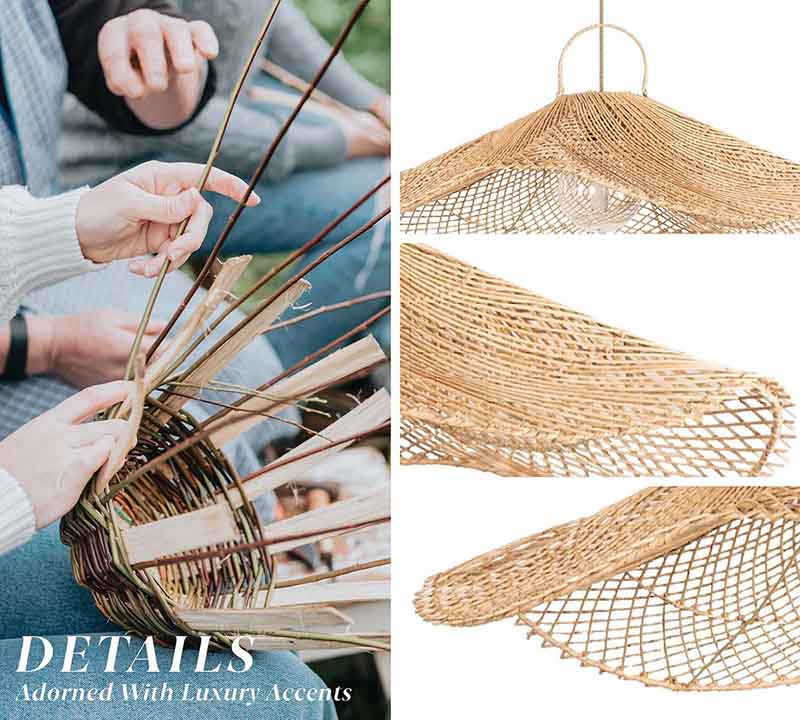Natural rattan maintains organic properties with unique grain patterns and ages naturally, while dyed rattan offers consistent coloring and often requires different maintenance approaches. The key distinctions lie in sustainability impact, durability factors, and aesthetic versatility. Processing methods significantly affect their respective lifespans, with natural rattan lasting 10+ years under proper care and dyed variants showing variable longevity based on treatment quality.
At Lighting a Greener Future, we believe that understanding rattan isn’t just about furniture—it’s about embracing a sustainable and artisanal future for our homes. Let me share our passionate journey through the world of natural and dyed rattan.
The Difference Between Natural and Dyed Rattan
The eternal dance between authenticity and innovation shapes our understanding of rattan materials.
Composition and Production
The natural fiber of rattan tells a story of resilience. Its core material and protective layer work in harmony, creating a material that’s both strong and flexible. Traditional craftsmen from the Indonesian Rattan Association have mastered the art of working with these fiber bundles, understanding how each component contributes to the final product.
Durability and Maintenance
Weather-resistant finish plays a crucial role in longevity. A well-maintained natural rattan piece can last over 10 years, proving its worth through time. The surface treatment process differs significantly between natural and dyed variants.
In high-humidity environments, natural rattan shows remarkable adaptability. I strongly believe that the industry’s push towards synthetic alternatives overlooks the inherent durability of properly treated natural rattan.
Through careful observation, we’ve seen how chemical treatment affects long-term performance. Proper maintenance becomes essential, especially for outdoor pieces.
Whether you’re planning an outdoor entertainment space or a cozy indoor retreat, understanding the durability differences between natural rattan pendants and outdoor rattan lighting can help you make informed decisions that balance both style and longevity.
Aesthetic Appeal
The traditional appeal of natural rattan brings warmth to any space. Its grain pattern creates unique textures that tell stories of tropical forests.
The color application process in dyed rattan has evolved significantly. Modern techniques ensure better color fastness, though some argue it lacks character.
Environmental sustainability factors influence aesthetic choices significantly. The ASEAN Rattan Initiative promotes responsible harvesting while maintaining visual appeal.
Misconceptions and Current Debates
Let’s clear the air about common misunderstandings in the rattan industry.
Common Misconceptions about Rattan Types
Here’s a comparative table of facts versus myths:
| Aspect | Myth | Reality |
| Durability | Dyed rattan always weaker | Depends on treatment |
| Environmental Impact | All dyes are harmful | Eco-friendly options exist |
| Outdoor Use | Natural rattan unsuitable | Proper treatment allows it |
| Cost | Natural always cheaper | Varies by quality |
| Maintenance | Dyed needs no care | Both require maintenance |
Current Debates in the Industry
The Sustainable Furniture Council actively discusses various perspectives. I challenge the common belief that dyed rattan is inherently less eco-friendly—it’s the production process, not the dyeing itself, that determines environmental impact.
What’s your take on the balance between preservation and innovation in rattan furniture?
Practical Considerations for Consumers
Making informed choices requires understanding both practical and aesthetic aspects.
Choosing the Right Type of Rattan for Your Needs
Consider these essential factors:
- UV resistance
- Material strength
- Color stability
- Wear patterns
- Eco-friendliness
Care and Maintenance Tips for Rattan Furniture
Natural rattan fiber requires specific care techniques. The Natural Fiber Board recommends:
- Regular dusting
- Avoiding direct sunlight
- Maintaining optimal humidity
- Periodic cleaning
- Professional restoration when needed
Have you considered how your lifestyle might affect your choice between natural and dyed rattan?
Unique Perspectives on Rattan Use in Design
Innovation meets tradition in modern rattan applications.
Cultural Significance of Rattan in Interior Design
The contemporary use of rattan reflects cultural evolution. According to recent findings, approximately 700 million people worldwide use rattan in various forms.
From the organic warmth of handmade rattan lighting to the structured elegance of geometric rattan pendants, both natural and dyed variations offer unique possibilities for creating distinctive atmospheric lighting in any space.
Innovative Uses of Rattan Beyond Furniture
Color absorption properties open new possibilities. The material’s flexibility allows for creative applications in:
- Wall coverings
- Architectural elements
- Decorative accessories
- Lighting fixtures
- Artistic installations
Conclusion: Making an Informed Choice
Your choice between natural and dyed rattan impacts both aesthetics and sustainability.
FAQ Analysis:
What specific chemical treatments are used in the dyeing process of rattan?
Professional rattan dyeing typically uses water-based or natural dyes combined with fixing agents to ensure color penetration and longevity.
How does the weight capacity differ between natural and dyed rattan furniture?
Natural rattan generally offers 15-20% higher weight capacity due to unaltered fiber strength, while dyed rattan’s capacity varies based on treatment intensity.
Can natural rattan be restored to its original color after fading?
Surface restoration through gentle sanding and natural oil treatment can partially restore color, but complete restoration to original hue isn’t possible.
What role does humidity play in rattan maintenance?
Optimal humidity levels between 40-60% help maintain rattan’s flexibility and prevent cracking or brittleness.
Are there specific regions known for producing higher quality rattan?
Indonesian and Philippine rattan, especially from sustainably managed forests, is considered premium quality due to optimal growing conditions and traditional harvesting methods.

